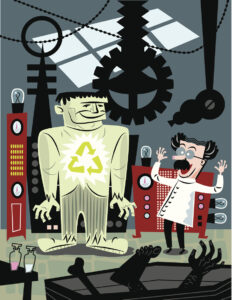One of the clearest consequences of school vouchers, tax credits for private schooling and other programs that provide parents with a nonpublic option for educating their children, is the growing demand for parochial placements – and not just because of their relatively low cost. The bold 2007 prediction by the Journal of Urban Economics that religious schools would prove to be the primary beneficiary of K-12 reform is turning out to be, if anything, an understatement.
Today in Indiana, where more than 34,000 children are publicly subsidized to attend private schools, a 2016 EdChoice survey found that the top reason families leave their local district is not “better academics” – which comes in second – but “religious environment/instruction.” Similarly, a study of New Orleans parents who put their children in a state-funded voucher program post-Katrina revealed that “having religious subject matter inform the curriculum” was a primary factor in their choice of schools.
With nearly half of all states offering some form of K-12 school choice, organizations such as Notre Dame University’s Alliance for Catholic Education (ACE) have been formed in recent years to ensure sufficient staffing for the predicted increase in parochial schools. John Schoenig, ACE’s director for teacher formation and education policy, has noted that there is already a shortage of administrators in regions where choice policies have been enacted. Yet despite this connection between the growth of school choice and the increasing demand for religious schools, the rather obvious implication – that future generations will likely be more religious – has gone remarkably unnoticed. Except for teacher union leaders, who have tried and failed to convince the courts that public funding of private schools constitutes the establishment of a state religion, social observers have largely missed the evidence that today’s families view parochial education as a useful counterweight to secular influences.
Research conducted by Sacred Heart University Professor Christel J. Manning shows that a growing number of what she calls “religiously unaffiliated” or “marginally religious” parents are intentionally outsourcing theological instruction to parochial schools. Whether because they themselves had fallen away from church before having children or perhaps had switched from their birth family’s very strict faith to a more liberal one or have simply ended up as time-pressed single parents, many mothers and fathers are more than happy to let religious schools define their kids’ faith.
Of course, the probability that spreading school choice programs will strengthen the religious convictions of coming generations does not mean every denomination will have an impact proportional to its current size – or any impact at all. For even with the public financing of tuitions, the organization of a parochial school system requires the kind of energy and dedication that many currently floundering denominations simply lack. Those religious groups that managed to sustain an educational infrastructure when it was not subsidized – Catholics with the most schools as well as Baptists, Lutherans, Orthodox Jews, Episcopalians and Seventh- day Adventists – would seem to have an initial advantage.
For Protestants, there is the added uncertainty as to which of its denominations will have the ability to reverse recent obfuscating tendencies. A 2014 survey by the National Association of Evangelicals found that nearly two-thirds of member churches had excluded their denominational affiliation from their name to appear less strict and opinionated to potential parishioners.
A sugarcoated faith may indeed attract those adults with little religious interest beyond the occasional weekend service and a few spiritually framed rites of passage, such as weddings and funerals. But denominations that aspire to influence coming generations will have to do more than provide a secular curriculum with a little Bible memorization sprinkled on the side.
Oxford University lecturer Nigel Fancourt, who is lead researcher of the Teaching Christianity in Religious Education project, finds that sophisticated topics, such as the relationship of faith to science, the meaning of other religions, the morality of abortion and the proper boundary between church and state, must be tackled directly and thoughtfully if students are to remain engaged. Parochial school instructors, such as Brian Douglas of the Ambrose Christian School in Meridian, Idaho, tend to agree. The failure to be theologically rigorous, he notes, only reinforces “a secular-sacred divide that undermines real Christian faith and practice.”
While it is too early to predict the effect of today’s education reform policies on specific Protestant denominations, there is no doubt that giving parents of all faiths the opportunity to religiously color their children’s educations has profound cultural implications going forward. For just as the declining influence of the clergy on higher education conferred legitimacy on a host of secular ideologies following World War I, so the increasingly widespread spiritual framing of the K-12 curriculum cannot help but have a very different effect.





